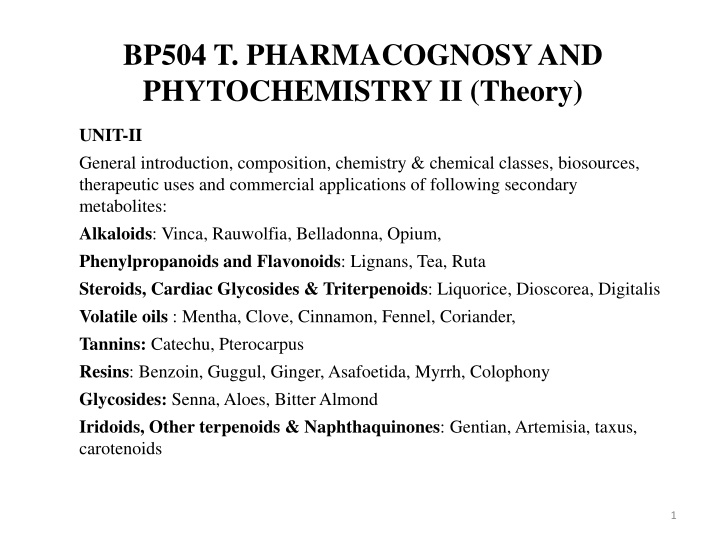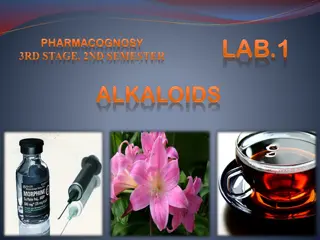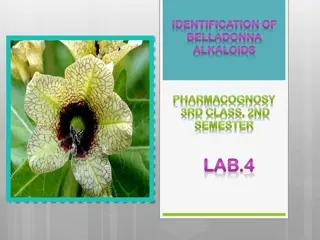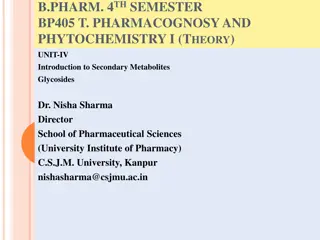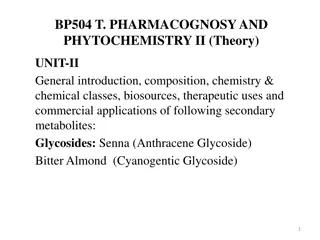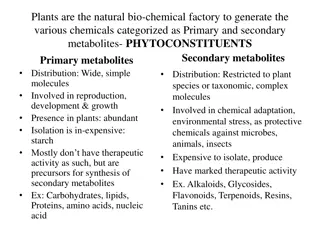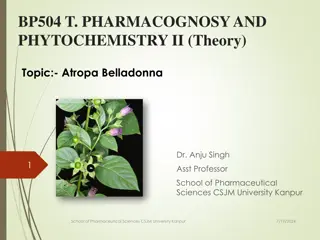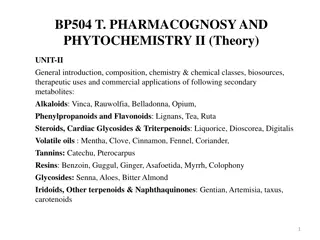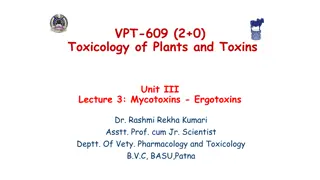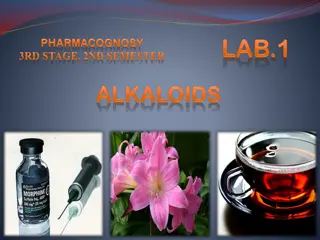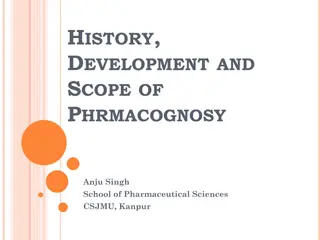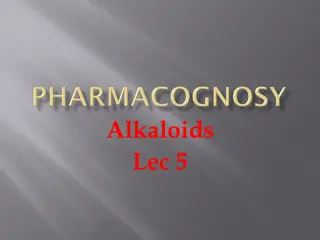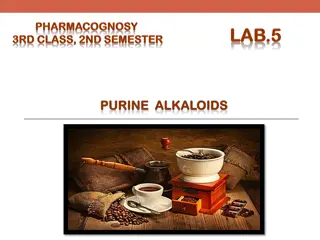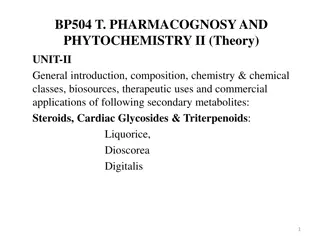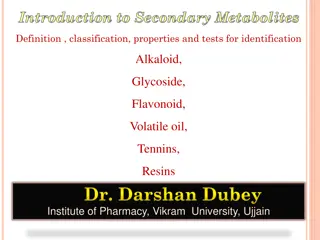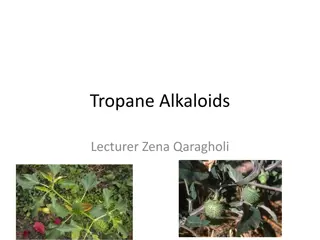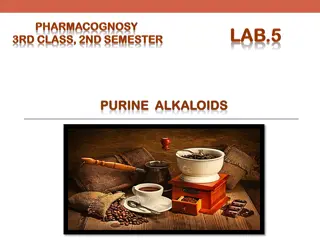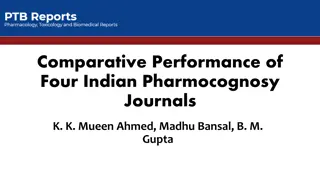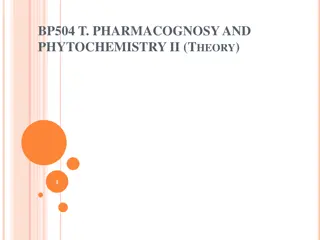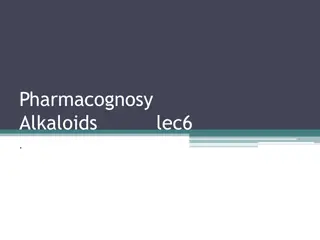Overview of Indole Alkaloids in Pharmacognosy and Phytochemistry II
Indole alkaloids are a significant group of naturally occurring compounds with diverse chemical structures and physiological actions. This unit delves into the general introduction, composition, chemistry, biosources, therapeutic uses, and commercial applications of various secondary metabolites, including alkaloids like Vinca and Rauwolfia, phenylpropanoids, flavonoids, steroids, cardiac glycosides, triterpenoids, volatile oils, tannins, resins, glycosides, iridoids, terpenoids, naphthaquinones, and carotenoids. The focus is on understanding the properties, distribution, functions, and importance of indole alkaloids in plant compounds.
Download Presentation

Please find below an Image/Link to download the presentation.
The content on the website is provided AS IS for your information and personal use only. It may not be sold, licensed, or shared on other websites without obtaining consent from the author.If you encounter any issues during the download, it is possible that the publisher has removed the file from their server.
You are allowed to download the files provided on this website for personal or commercial use, subject to the condition that they are used lawfully. All files are the property of their respective owners.
The content on the website is provided AS IS for your information and personal use only. It may not be sold, licensed, or shared on other websites without obtaining consent from the author.
E N D
Presentation Transcript
BP504 T. PHARMACOGNOSY AND PHYTOCHEMISTRY II (Theory) UNIT-II General introduction, composition, chemistry & chemical classes, biosources, therapeutic uses and commercial applications of following secondary metabolites: Alkaloids: Vinca, Rauwolfia, Belladonna, Opium, Phenylpropanoids and Flavonoids: Lignans, Tea, Ruta Steroids, Cardiac Glycosides & Triterpenoids: Liquorice, Dioscorea, Digitalis Volatile oils : Mentha, Clove, Cinnamon, Fennel, Coriander, Tannins: Catechu, Pterocarpus Resins: Benzoin, Guggul, Ginger, Asafoetida, Myrrh, Colophony Glycosides: Senna, Aloes, Bitter Almond Iridoids, Other terpenoids & Naphthaquinones: Gentian, Artemisia, taxus, carotenoids 1
ALKALOIDS German Scientist: Carl F.W. Meissner 1815 , Alkali like : Hence the word Alkaloids Definition: Group of naturally occurring organic compounds, basic in nature, contain 1 or more nitrogen atoms in heterocyclic ring, posses specific physiological action Distribution: Abundant in angiosperm i.e. higher plants Occurance: as salts of organic acid (oxalic , citric, acetic, maleic, lactic, fumaric, acid etc) Function in plants: Protective: against insects, herbivores (bitterness, toxicity) Some are Product of detoxification (waste products) Reservoir for protein synthesis, Source of N in case of deficiency in plants 2
INDOLE ALKALOIDS (Vinca & Rauwolfia) Indole (1-H-indole)- a benzopyrrole- benzene & pyrrole rings are at 2, 3-positions of the pyrrole. Indole nucleus- large no. of naturally occurring compds. Commercial importance as a component of perfumes. Isoindole (1 H isoindole), the isomer- benzene & pyrrole rings - fused at the 3 and 4 positions of the pyrrole, unstable. Few derivatives, the simplest being N-methylisoindole. 4 3 4 1 NH 2 N 1 3 2 H ISO INDOLE INDOLE 3
INDOLE ALKALOIDS Indole 1st obtained- 1866- Adolf von Baeyer. Interest in indole chemistry- 1930- essential amino acid, tryptophan, the plant growth hormone, heteroauxin, & several groups of important alkaloids are Indole derivatives. Indole- colorless crystalline solid (mp 52 54 C, bp 254 C). The molecule is planar and has only moderate polarity. Indole- good solubility in petroleum ether, benzene, chloroform and hot water. The solubility in cold water is only 1:540 at 25 C; Water is a good solvent for purification by recrystallization. Indole forms salts with high concentrations of both strong bases and strong acids. 4
INDOLE ALKALOIDS Many indole alkaloids include isoprene groups also So called as terpene indole alkaloids or secologanin tryptamine alkaloids Largest class of alkaloids Amino acid tryptophan is the precursor for indole alkaloids Based on biosynthesis : Two types Isoprenoids and Non isoprenoids Non isoprenoids: sub classification 1. Simple derivatives of indole: biogenic amines tryptamine & 5-hydroxy tryptamine (serotonin), camalexin- plant Arabidopsis thaliana 5
Classification of Indole alkaloids 2. Simple derivatives of -carboline- harmine, harmaline, harmane isolation in1838 3. Pyrolo-indole alkaloids- produced by methylation of indole nucleus at 3rd position & nucleophilic addition at C atom at position 2, closure of ethylamino grp into a ring. Ex. Physotigmine-1864 4. Indole-3-carbinol 5. Indole-3-acetic acid 6. Tryptamines 7. Carbazoles 6
Classification of Indole alkaloids Isoprenoids are synthesised from dimethyl allyl pyrophosphate and iso pentenyl pyrophosphate Isoprenoid: Hemiterpenoids: Ergot Monoterpenoids or secologanin tryptamine alkaloids Contains 9-10 C fragments Ajmalicine (C9), Catharanthine (C10) Vindoline (C10) Structure of lysergic acid the tryptophan fragment is colored in yellow and the isoprenoid part from DMAPP is blue 7
Classification of Indole alkaloids Bisindole alkaloids: dimers of Strictosidine: Vincristine & vinblastine Catharanthine is precursor for vinblastine & vindoline Yohimbine: quebrachine, indoloquinolizidine alkaloid derived from the bark of the African tree Pausinystalia johimbe Vinca Strychinine : Strchynos nuxvomica Ellipticine: Ochrosia elliptica and Rauvolfia sandwicensis 8
Vinca Alkaloids Vinca alkaloids were found out in the 1950's by Canadian scientists, Robert Noble and Charles Beer for the first time. Are Dimeric alkaloids having Indole and Dihydroindole nuclei. Vincristine and Vinblastine are the major alkaloids in Vinca, they differs only in the substitution on the N- atom of the Dihydroindole nucleus. Although, the name represents alkali like some do not exhibit alkaline properties. There are four major vinca alkaloids in clinical use: Vinblastine (VBL), vinorelbine (VRL), vincristine and vindesine (VDS) 9
Classification of vinca alkaloids 1st generation (natural): vincristine & vinblastine 2nd generation (semisynthetic): vindesine, vinorelbine 3rd generation (synthetic): vinflunine Vinca alkaloids have dimeric chemical structure- 2 basic multi-ringed units, an indole nucleus (catharanthine) , a dihydroindole nucleus (vindoline), joined together with other complex systems 10
Vinca - Periwinkle Vinca is dried entire plant of catharanthus roseus apocynaceae 1- Monomeric Alkaloids:These are alkaloids that contain either indole or indoline:Indole monomers e.g. Catharanthine Indoline monomers e.g. Vindoline and Vincamine. Vincamine Enhances the cerebral blood flow, facilitate cerebral circulation metabolism and increase general activity. Vincamine is used in cerebral vascular deficiency and atherosclerosis in elderly patients. 12
Vinca Alkaloids Dimeric Alkaloids: These are dimeric alkaloids having indole and indoline (dihydro-indole) nuclei Homogenic dimmers: Composed of two indole or indoline monomers. Mixed dimmers: One indole and one indoline monomers e.g. Vincristine and Vinblastine. e.g. Vinblastine and Vincristine They occur in very minute amounts in Vinca 500 Kg of the plant yield only 1 gm of vincristine. Vincristine is more active but isolated in smaller amounts than Vinblastine. Vinblastine can be converted to vincristine chemically or by microbial transformation using Streptomyces albogriseolu . 13
Vinca Vincristine and Vinblastine differ only in the substitution on the N-atom of the dihydroindole nucleus. Vinblastine (Vinca leukoblastine) is produced by coupling of Catharanthine and Vindoline. Vincristine (leurocristine) has CHO instead of CH3in the vindoline part of Vinblastine. Uses: Vincristine used in treatment of Leukemia in children, small cell lung cancer, cervical and vaginal cancers. Vinblastine is used for treatment of Hodgkin s disease. Mechanism of action: They are antimitotics. They bind to tubuline and prevent the formation of the microtubules and so block the mitosis in meta phase.. 14
Vinca Semisynthetic derivatives of Vinca alkaloids Vindesine: It is used for treatment of acute lymphoid leukemia in children. Vinorelbine: It is an oral anticancer with broader activity and lower neurotoxicity than vinblastine. Tests for identification of Vinca alkaloids: 1- Vanillin /HCl reagent gives with: Vinblastine a pink color. Vincristine an orange-yellow color. 2- Van-Urk's reagent: Reddish-brown color. 15
Chemical constituents No. of indole alkaloids, 20 dimeric indole dihydroindole alkaloid anticancer activity Other alkaloids- ajmalicine, lochnernine, serpentine, tetrahydroalstonine Applications: anticancer Vincristine sulphate: antineoplastic, arrests mitosis at metaphase. Given by IV in acute leukemia in children In adults: reticulum cell sacroma, lymphocarcinoma, myosarcoma, haussian disease 16
Applications and dose Vinblastin sulphate: antineoplastic, supress the immune response and mainly used in choriocarcinoma Dose: Vincristin: 10-30 g/kg bwt max- 2mg Vinblastin: 100 g/kg bwt 17
